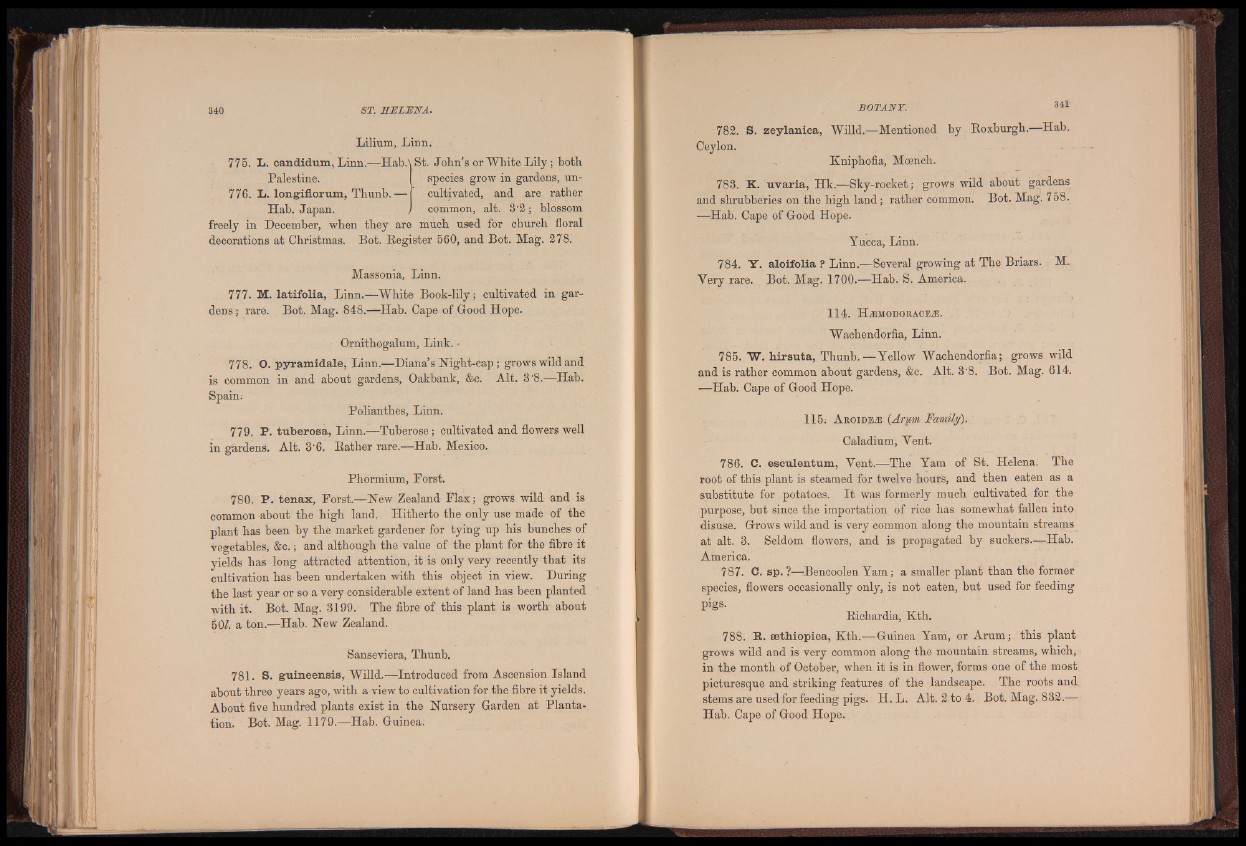
Lilium, Linn.
775. L. candidum, Linn.—-Hab.ySt. John’s or White L ily ; hoth
species Palestine. grow in gardens, un-
776. L. longiflorum, Thunb.—
Hab. Japan.
cultivated, and are rather
common, alt. 3 '2 ; blossom
freely in December, when they are much used for church floral
decorations at Christmas. Bot. Register 560, and Bot. Mag. 278.
Massonia, Linn.
777. M. latifolia, Linn.—White Book-lily; cultivated in gardens;
rare. Bot. Mag. 848.—Hab. Cape of Good Hope.
Ornithogalum, Link. •
778. O. pyramidale, Linn.—Diana’s N ight-cap; grows wild and
is common in and about gardens, Oakbank, &c. Alt. 3'8.—Hab.
Spain.
Polianthes, Linn.
779. P. tuberosa, Linn.—Tuberose; cultivated and flowers well
in gardens. Alt. 36 . Rather rare.—Hab. Mexico.
Phormium, Forst.
780. P. tenax, Forst.—New Zealand Flax; grows wild and is
common about the high land. Hitherto the only use made of the
plant has been by the market gardener for tying up his bunches of
vegetables, &c.; and although the value of the plant for the fibre it
yields has long attracted attention, it is only very recently that its
cultivation has been undertaken with this object in view. During
the last year or so a very considerable extent of land has been planted
with it. Bot. Mag. 3199. The fibre of this plant is worth about
60/. a ton.—Hab. New Zealand.
Sanseviera, Thunb.
781. S. guineensis, Willd.—Introduced from Ascension Island
about three years ago, with a view to cultivation for the fibre it yields.
About five hundred plants exist in the Nursery Garden at Plantation.
Bot. Mag. 1179.—Hab. Guinea:
7 8 2 . S. zeylanica, Willd.—Mentioned by Roxburgh.—Hab.
Ceylon.
Kniphofia, Moench.
7 8 3 . K. uvaria, Hk.—Sky-rocket; grows wild about gardens
and shrubberies on the high land; rather common. Bot. Mag. 7 5 8 .
—Hab. Cape of Good Hope.
Yucca, Linn.
7 8 4 . Y. aloifolia P Linn.— Several growing at The Briars. M.
Very rare. Bot. Mag. 1 7 0 0 .—Hab. S. America.
1 1 4 . H . em o d o r a c e .®.
Wachendorfia, Linn.
7 8 5 . W. hirsuta, Thunb.—Yellow Wachendorfia; grows wild
and is rather common about gardens, &c. Alt. 3 '8 . Bot. Mag. 6 1 4 .
—Hab. Cape of Good Hope.
1 1 5 ; A r o i d e a s {Arym Family).
Caladium, Vent.
7 8 6 . C . e s c u l e n t u m , Vent.— -The Yam of St. Helena. The
root of this plant is steamed for twelve hours, and then eaten as a
substitute for potatoes. I t was formerly much cultivated for the
purpose, but since the importation of rice has somewhat fallen into
disuse. Grows wild and is very common along the mountain streams
at alt. 3 . Seldom flowers, and is propagated by suckers.—Hab.
America.
7 8 7 . C. sp. ?—-Bencoolen Yam; a smaller plant than the former
species, flowers occasionally only, is not eaten, but used for feeding
pigs.
Richardia, Kth.
7 8 8 . R. sethiopica, Kth.—Guinea Yam, or Arum; this plant
grows wild and is very common along the mountain streams, which,
in the month of October, when it is in flower, forms one of the most
picturesque and striking features of the landscape. The roots and
stems are used for feeding pigs. H. L. Alt. 2 to 4 . Bot. Mag. 8 3 2 .—
Hab. Cape ,of Good Hope.